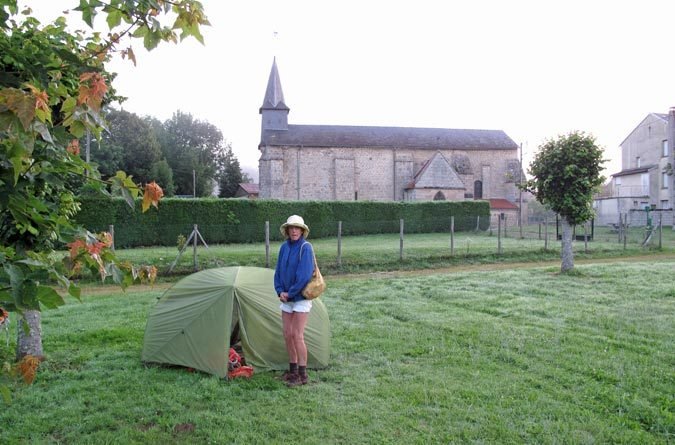
Tuesday, 17 July 2012
Distance 21 km
Duration 4 hours 10 minutes
Ascent 254 m, descent 231 m
Map 140 of the TOP100 lime-green series
When Keith shook me awake at 6:10 am, I was glad to be released from a complicated, worrying dream, which was probably caused by my anxiety about his leg.
As we feared, the pills had not worked overnight. It was freezing outside the tent, with frost on the grass and the hills hidden by fog.
We shivered our way through muesli at the stone table and hurried off, as soon as Keith had swallowed two painkillers and yet another anti-inflammatory pill.
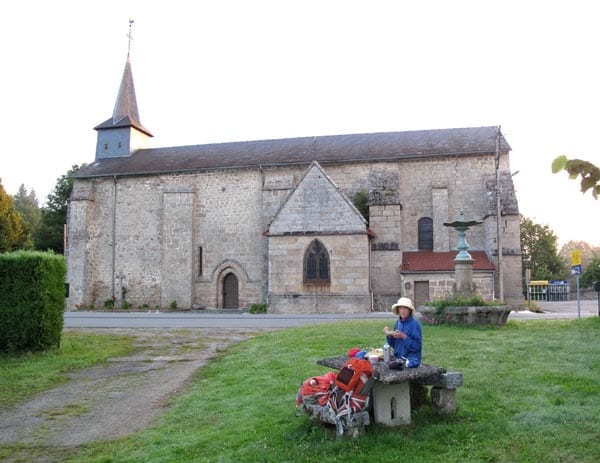
The hotel where we had dined so splendidly last night did not open until 8 am (it was not quite 7 am), which was a sorrow, but we told ourselves that we really needed to get moving as we had a long way to go – seven kilometres on a minor road, followed by what we estimated to be 24 more along the D13 to Ahun.
The tiny thread of road that forked off at St-Hilaire was as quiet as it must have been a thousand years ago.
Swathes of mist clung to the fields where a herd of brown cows grazed. Before long the ground rose slightly and we entered a patch of forest where, according to the signs, there was a surviving Roman bridge, le Pont Péri, just off the road. However Keith was in such pain that he did not want to take any unnecessary steps, so we never saw it.
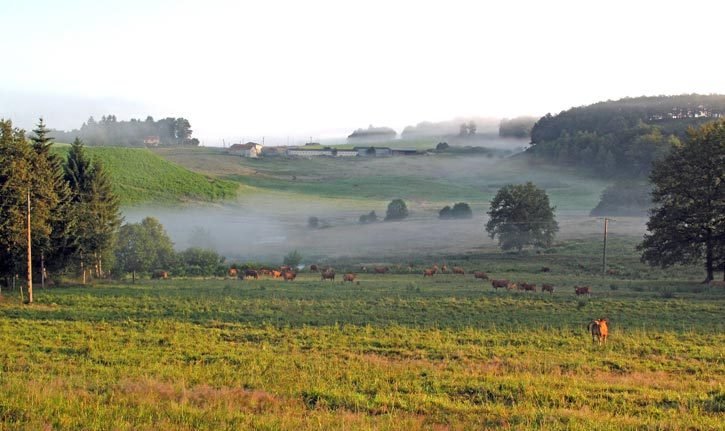
Despite this it was a beautiful walk, alternating between farms and woods, and after an hour and a half we arrived at the bigger road, to be confronted with a signpost proclaiming that the distance to Ahun was 14 km, not 24 km as we had thought.
Our old blue map had a misprint, the number 31 where it should have been 21 – this has been fixed on the new lime-green map. It was a joyous moment and even Keith rallied somewhat.
Soon we came to a lake with a few lonely houses beside it – la Chapelle-St-Martial, picturesque but deserted. At the end of the lake, the road divided into three but we stayed on the middle one, which kept on straight ahead in a business-like way.

There was a sprinkling of cottages along this stretch, several with GB cars parked outside, and we met an English-speaking dog being summoned by its owner, who said she had a holiday house nearby.
We trudged on and on over rolling hills until, just past the hamlet of le Sec, Keith could go no further, so we sat down to rest on a little piece of bitumen that had once been a side road. Although we had bread and cheese with our water, it did not have the restorative effect of a bar, and when we set off again Keith’s leg was worse than ever. He took two more painkillers, but the rest of the walk was terrible, best passed over in silence.
After an eternity (actually only an hour), we came to a big, ugly Intermarché on the crest of a hill and saw the town of Ahun stretching down below us.
Then suddenly we were at the gates of the camping ground, which was just below the Intermarché. The shower block was modern, the lawns spacious and freshly mown, but there was not a soul in residence, except for a lone cyclist sitting on a chair beside his tiny tent, far away.
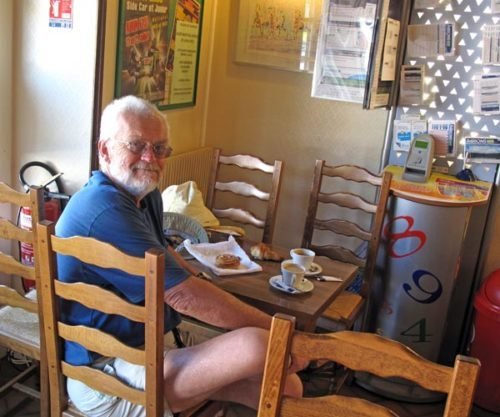
We collapsed gratefully onto the grass and lay still, incapable of movement. After a while the desire for coffee overcame our fatigue and we changed into sandals, left our packs under a tree and crept down to the town, which was about half a kilometre further on.
Armed with pastries from the boulangerie, we went into a nearby bar for our first coffee of the day, just as the bells of midday rang out. It was not the prettiest of bars but we loved it.
While sitting there, we opened our maps and worked out a new route for tomorrow. Instead of following a series of tiny roads via Cressat, we decided to go via Chénérailles, which we knew had a camping ground, in case Keith’s leg got too bad to make it all the way to Gouzon. The new way involved a couple of stretches along main roads, but we thought it worth the sacrifice.
It seemed a long way back to the camping ground with Keith limping more than ever. Nevertheless he managed to get there and go off for a shower. The lone cyclist came over to me to ask whether Keith was ill, having seen him prostrate on the ground before. His blue eyes bulged with sympathy when I explained about the leg.
He was far from young, indeed a grandfather, with a bald head and a lively, genial face. I found out that he was from Lille, on his way home now, and that every year he spent a month cycling, to the amazement of his grandchildren. Last year he cycled all the way to Compostela and back, a distance of 5,200 km, but this year he had not gone as far because of all the rain and was now having a rest day to dry off his gear.

He was a fountain of useful information. He told us that the orange plastic chair outside his tent was borrowed from the adjoining tennis courts – there were plenty more, he said – and that there was a break in the fence between the camping ground and the Intermarché, if we were thinking of doing any shopping. As to dining, he had eaten splendidly for €12 at midday at a place called the Amer-Doux, down in the village.
Once we (and our clothes) were clean, we lay about on the thick, springy grass, reading and dozing, enjoying the happy sounds of a group of children running about in the sports field below the camping ground. Then we went up through the hole in the fence to the Intermarché, which was a dauntingly huge shop, but not very well stocked with the things we needed (muesli and powdered milk).
On the way back past the tennis courts, we took two chairs and were sitting comfortably when two more cyclists arrived. It turned out that they were English and were not only fanatical cyclists, but also marathon runners. The man stripped off his shirt to reveal a little barrel chest and a skinny frame, but presumably it was all muscle. They too had been rained on for many days and were having a rest day tomorrow.
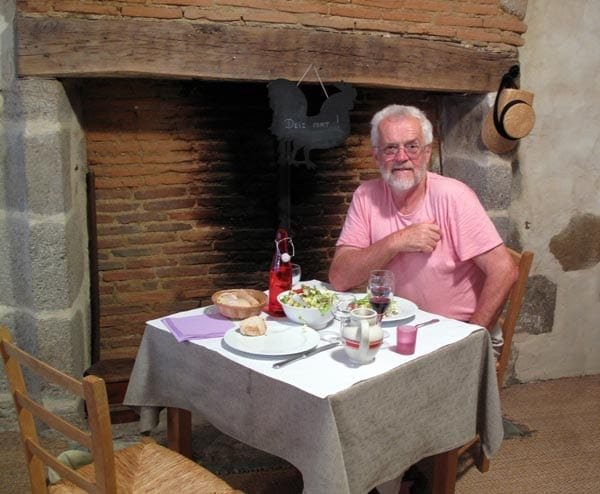
In due course we set off in search of dinner, leaving our English companions stirring something over a spirit stove.
The town looked dismal as we reached the main cross street (the D942), which was narrow and choked with trucks. Most of the shops were shut. We found the Amer-Doux in a side lane, but it was closed in the evenings.
Having walked a little way past the church to find our turn-off for tomorrow, we retreated to the only open bar that we could see, a sorry looking place, where we had apéritifs alone under the scowling gaze of the barwoman.
She said that they did not serve meals but that there was a crêperie opposite. The crêperie did not look much better than the bar, but we had no choice so we went in.
The first thing we came to was a gloomy covered area set with tables, probably a converted garage, but beside it, through a glass door, was a lighted room that looked more welcoming.
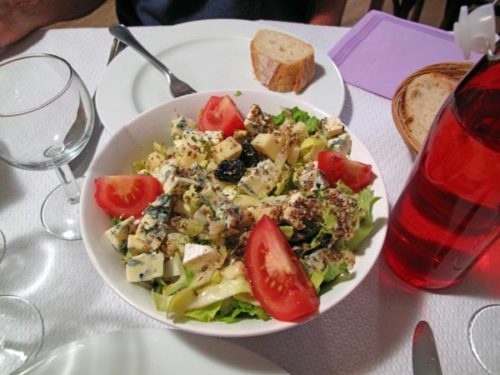
Although we were the first customers of the night, the tables filled up rapidly and later arrivals had to dine outside, including a troop of exhausted, mud-spattered boy scouts.
It was a lovely old room with exposed stonework and a vast fireplace. The walls were covered with tools and ornaments from Brittany, and there was a hand-written sign with the words ‘Deim mat!’ (the Breton equivalent of ‘Bon jour!’).
Keith was in despair because of his leg, fearing that he would not be able to keep going, and I had to go round to his side of the table and cradle his head to my bosom like a mother. But the food and the convivial atmosphere soon restored his spirits.
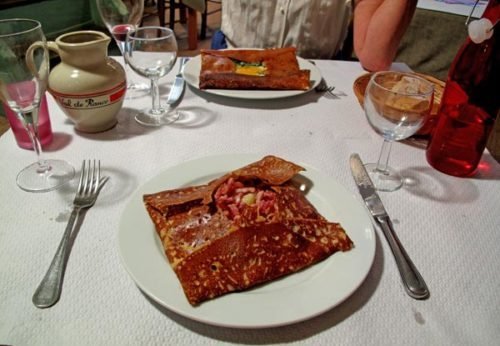
Brittany is the land of the crêpe, and even more, of the galette, a darker, coarser local version.
We began our dinner with a large, shared salade auvergnate, with the characteristic combination of blue cheese and nuts, then had galettes. Keith’s was filled with cheese and ham, while mine had spinach and eggs and went by the name of “Popeye”.
Much restored in both body and soul, we strolled back to the camping ground, where the gates had been shut by some unseen hand, but not locked.
A camping car drove up at that moment, so I opened the gates out of common kindness to let them in. All the cyclists were fast asleep.
Previous section: Treignac to St-Hilaire-le-Château